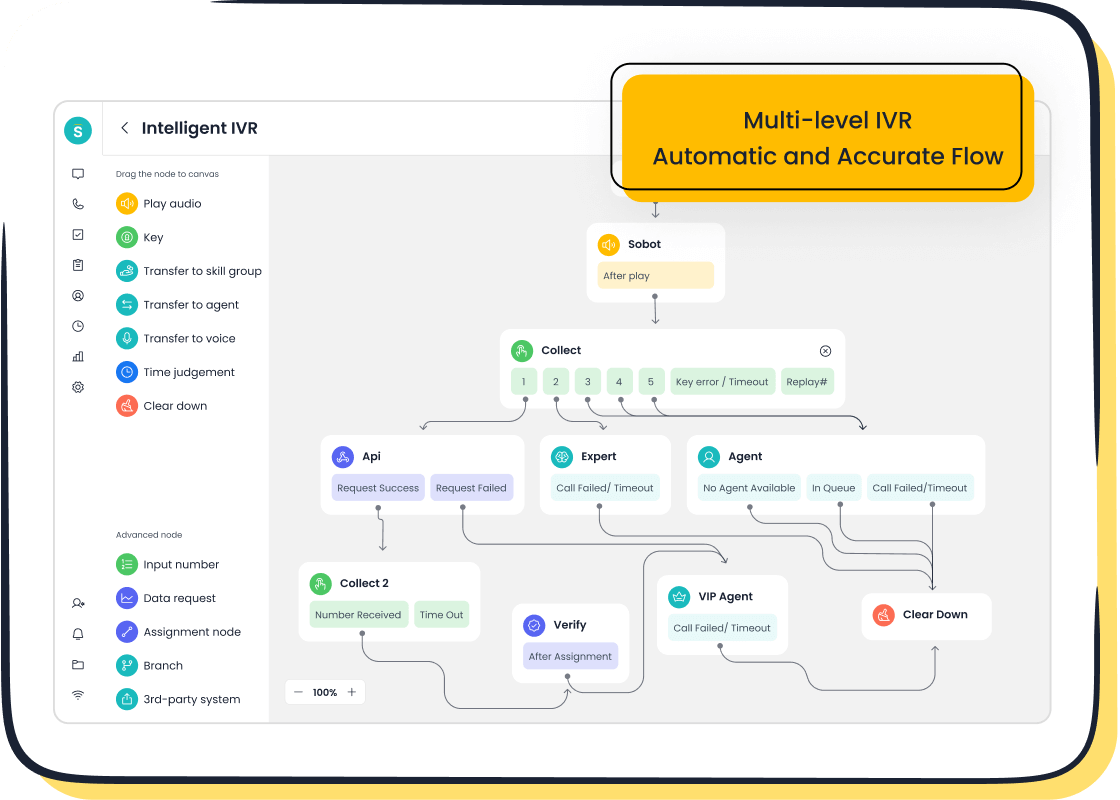How to Implement Omnichannel Service Efficiently

Efficient omnichannel service has become essential for modern businesses. It ensures that customers experience seamless interactions across all communication channels. This approach not only enhances customer satisfaction but also boosts operational efficiency. For instance:
- 89% of buyers return to businesses excelling in omnichannel engagement.
- Companies with poor omnichannel strategies retain only 33% of their customers.
By integrating customer data across channels, you can resolve issues faster, reduce costs, and improve service quality. To achieve this, focus on unifying communication platforms, synchronizing data, and leveraging tools like Sobot's solutions for smarter workflows.
Understanding Omnichannel Service and Its Importance

What is omnichannel service?
Omnichannel service refers to a unified approach to customer service that connects all communication channels into one seamless experience. For example, a customer might start a conversation on social media and continue it via email or phone without repeating their issue. This strategy ensures that customers receive consistent and personalized support, no matter which channel they use. By integrating customer data across channels, businesses can provide faster resolutions and improve the overall customer experience.
Did you know that 88% of customers value their service experience as much as the products they buy? This highlights the importance of creating a smooth and connected customer journey. Omnichannel customer service achieves this by breaking down silos between channels and ensuring every interaction feels cohesive.
Key differences between omnichannel and multichannel approaches
At first glance, omnichannel and multichannel strategies may seem similar, but they differ significantly. A multichannel approach offers multiple communication channels, such as email, phone, and social media, but these channels often operate independently. This means customers may need to repeat information when switching between channels, leading to frustration.
In contrast, an omnichannel strategy integrates all channels into a single system. This allows you to track customer interactions across platforms and provide a seamless experience. For instance, companies with effective omnichannel strategies retain 89% of their customers, compared to just 33% for those with less effective approaches. The table below illustrates this difference:
| Strategy Type | Customer Retention Rate |
|---|---|
| Omnichannel | 89% |
| Multichannel | 33% |
By adopting an omnichannel approach, you can eliminate communication gaps and enhance customer satisfaction.
Why an omnichannel customer service strategy is essential for businesses
An omnichannel customer service strategy is no longer optional—it’s essential for staying competitive. Customers expect consistent interactions across all channels. In fact, 75% of customers want seamless communication between departments, and 35% prefer speaking to the same service representative regardless of the channel.
This strategy also improves operational efficiency. By unifying customer data, you can reduce the time agents spend searching for information. Additionally, tools like Sobot's Omnichannel Solution help automate repetitive tasks, allowing your team to focus on complex issues. For example, Opay, a financial service platform, used Sobot's omnichannel solution to increase customer satisfaction from 60% to 90% while reducing costs by 20%.
Investing in omnichannel customer service not only enhances the customer experience but also drives business growth. It’s a win-win for both you and your customers.
Preparing Your Organization for Omnichannel Service
Assessing your customer service needs and goals
Before diving into an omni-channel setup, you need to evaluate your customer service needs and define clear goals. Start by analyzing your current performance metrics. Key indicators like Customer Satisfaction Score (CSAT) and Net Promoter Score (NPS) provide valuable insights into customer loyalty and satisfaction. For example:
| KPI Type | Importance |
|---|---|
| Customer Satisfaction Score (CSAT) | Indicates customer satisfaction levels and areas for improvement. |
| Net Promoter Score (NPS) | Provides insights into customer loyalty and overall sentiment towards the brand. |
Use targeted surveys to measure these metrics and identify areas needing improvement. Regularly assess customer interactions to pinpoint gaps in service quality. Setting measurable goals, such as reducing response times or increasing first-contact resolution rates, ensures your omni-channel setup aligns with your business objectives.
Identifying the most relevant communication channels for your audience
Understanding your audience is crucial for selecting the right channels. Analyze demographics like age, location, and media consumption habits. For instance, younger audiences may prefer social media or chat apps, while older demographics might favor email or phone support. Tools like Google Analytics can help you track user behavior and identify the most effective channels for engagement.
Take inspiration from brands like Nike, which tailors its messaging to resonate with specific demographics. By segmenting its audience, Nike ensures its communication channels align with customer preferences. Similarly, your omni-channel setup should prioritize the platforms your audience uses most frequently. This ensures seamless interactions and boosts customer satisfaction.
Choosing the right tools, such as Sobot's Omnichannel Solution
Selecting the right tools is critical for a successful omni-channel setup. Sobot's Omnichannel Solution offers a unified platform that integrates multiple channels, including voice, email, and social media. This solution automates repetitive tasks, provides a unified workspace for agents, and delivers analytics for performance monitoring. The results speak for themselves:
| Metric/Feedback | Result |
|---|---|
| Customer satisfaction rate | 95%+ |
| Problem resolution rate | 85% |
| Positive feedback rate | 96%+ |
| Self-service question resolution | 22.2% |

With Sobot, you can reduce inbound discussion volume by 20% and improve customer happiness rates to 99%. These tools ensure your omni-channel setup delivers consistent, efficient, and personalized service across all channels.
Setting measurable goals and KPIs for your omnichannel strategy
Setting measurable goals and tracking key performance indicators (KPIs) are essential for evaluating the success of your customer service strategy. These metrics help you monitor progress, identify areas for improvement, and ensure your efforts align with business objectives.
Key KPIs to Measure Success
To effectively measure your omnichannel strategy, focus on the following KPIs:
| KPI | Description |
|---|---|
| Customer Satisfaction Score | Measures client satisfaction through surveys and feedback, essential for evaluating customer journey. |
| Conversion Rate | Percentage of customers making purchases after engaging with the omnichannel strategy. |
| Customer Lifetime Value | Total value of a customer over their entire journey, indicating the effectiveness of the strategy. |
| Engagement Score | Measures the quality of engagement with the omnichannel approach, including various interaction metrics. |
| Loyalty Score | Indicates the number of customers who remain loyal to the brand, reflecting the strategy's success. |
| Net Promoter Score | Evaluates customer sentiment by measuring the likelihood of recommending the brand, crucial for improvement. |
These KPIs provide a comprehensive view of how well your customer service strategy performs across different touchpoints.
Tips for Setting Goals
When setting goals, align them with your business objectives. For example:
- Aim to improve customer satisfaction by 10% within six months.
- Increase conversion rates by optimizing engagement across channels.
- Enhance customer lifetime value by delivering consistent and personalized experiences.
Tracking customer journey metrics offers valuable insights into how customers interact with your brand. Use these insights to refine your strategy and address pain points. Additionally, measure the performance of individual channels to allocate resources effectively and maximize results.
Pro Tip: Regularly review your KPIs to ensure they remain relevant as your business evolves. Adjust your goals to reflect changes in customer behavior or market trends.
By setting measurable goals and monitoring KPIs, you can create a customer service strategy that not only meets but exceeds customer expectations. This approach ensures continuous improvement and long-term success.
Step-by-Step Guide to Implementing Omnichannel Service

Integrating communication channels into a unified platform
To create a seamless omnichannel experience, you must integrate all communication channels into a single platform. This ensures that your team can manage interactions efficiently without switching between tools. Start by evaluating your current systems and identifying gaps. Define your organization's communication needs to select the right tools. For example, Levi’s uses an omnichannel approach to connect online and in-store shopping, while Domino’s Pizza integrates ordering channels like mobile apps and voice assistants.
Follow these steps for successful integration:
- Develop a phased rollout sequence, prioritizing communication-intensive departments.
- Train employees and IT administrators through interactive workshops.
- Integrate the platform with existing tools to streamline workflows.
- Regularly gather feedback to identify areas for improvement.
Sobot's Omnichannel Solution simplifies this process by unifying voice, email, and social media channels into one workspace. It also provides analytics to monitor performance and optimize operations.

Configuring smart routing methods with tools like Sobot's Voice/Call Center
Routing plays a critical role in delivering efficient omni-channel customer service. Smart routing methods, such as skill based routing, queue based routing, and external routing, ensure that customer inquiries reach the right agent quickly. Tools like Sobot's Voice/Call Center offer advanced routing features, including intelligent IVR and rule-based workflows.
Here’s how smart routing improves performance:
- Skill based routing assigns inquiries to agents with the required expertise.
- Queue based routing prioritizes customers based on wait times or urgency.
- External routing directs calls to external teams when necessary.
The benefits are clear. Businesses using Sobot's Voice/Call Center report a 20% reduction in inbound discussion volume and a 95% customer satisfaction rate.
| Metric | Value |
|---|---|
| Reduction in inbound discussion volume | 20% |
| Customer satisfaction rate | 95% |
| Problem resolution rate | 85% |

Synchronizing customer data across all channels
Consistency is key in omnichannel customer service. Synchronizing customer data across all channels ensures that agents have access to complete interaction histories. This eliminates the need for customers to repeat information and enhances their experience.
Research shows that businesses with effective omnichannel strategies retain 89% of their customers, compared to just 33% for those with less effective approaches.
| Metric | Value |
|---|---|
| Repeat customers in effective omnichannel | 89% |
| Customer retention in less effective omnichannel | 33% |
Sobot's Omnichannel Solution excels in data synchronization. It consolidates customer information into a unified workspace, enabling personalized and efficient service. By leveraging this feature, you can improve first-contact resolution rates and build stronger customer relationships.
Testing the system for seamless functionality and user experience
Testing your omnichannel system is crucial to ensure it delivers a smooth and efficient experience for both customers and agents. A well-tested system minimizes errors, enhances user satisfaction, and ensures all communication channels work harmoniously.
Start by monitoring performance metrics in real-time. This helps you identify potential issues before they affect the customer experience. Focus on key metrics such as customer satisfaction, Net Promoter Score (NPS), and Conversion Rates (CVRs). These indicators provide valuable insights into how well your system meets user expectations.
Pro Tip: Use tools like Sobot's Omnichannel Solution to track these metrics effortlessly. Its analytics feature consolidates data from all channels, giving you a clear picture of your system's performance.
Regularly measure Key Performance Indicators (KPIs) and collect customer feedback. Surveys and feedback forms help you understand what works and what needs improvement. For example, ask customers about their experience navigating between channels or resolving issues. This feedback is essential for refining your system.
Here’s a checklist to guide your testing process:
- ✅ Verify that all communication channels integrate seamlessly.
- ✅ Test smart routing methods to ensure inquiries reach the right agents.
- ✅ Check data synchronization across channels for consistency.
- ✅ Simulate customer interactions to evaluate response times and resolution rates.
Finally, involve your team in the testing phase. Encourage agents to report any challenges they face while using the system. Their input can uncover hidden issues and improve overall functionality.
By thoroughly testing your omnichannel system, you ensure a seamless user experience that meets customer expectations and drives satisfaction.
Optimizing and Maintaining Your Omnichannel Service
Training your team to deliver consistent service across channels
Your team plays a vital role in delivering effective omnichannel customer service. To ensure consistency, train your staff to handle interactions across all channels. Start by familiarizing them with the tools and platforms in your omni-channel setup. For example, Sobot's Omnichannel Solution provides a unified workspace that simplifies managing customer support.
Focus on teaching your team how to maintain a consistent tone and approach, regardless of the channel. Role-playing exercises can help them practice responding to inquiries on social media, email, and voice calls. Encourage them to use customer data effectively to personalize interactions. This builds trust and improves satisfaction.
Regular training sessions keep your team updated on new features and best practices. Use feedback from customers to identify areas where additional training is needed. A well-trained team ensures your omnichannel strategy delivers seamless and efficient customer support.
Monitoring performance and gathering customer feedback
Monitoring performance is essential for maintaining a high standard of omni-channel service. Use analytics tools to track key metrics like response times, resolution rates, and customer satisfaction scores. Sobot's Omnichannel Solution offers real-time performance insights, making it easier to identify trends and areas for improvement.
Gather feedback directly from customers to understand their experiences. Use surveys, feedback forms, or follow-up emails to collect their opinions. Ask specific questions about their interactions across different channels. For example, "Was your issue resolved quickly?" or "Did you find the transition between channels smooth?"
Analyzing this feedback helps you pinpoint pain points and refine your approach. It also shows customers that you value their input, which strengthens loyalty. Regularly reviewing performance and feedback ensures your omnichannel customer service remains effective and customer-focused.
Leveraging analytics to identify areas for improvement
Analytics are a powerful tool for optimizing your omni-channel strategy. They provide valuable insights into how customers interact with your channels. For instance, you can identify which channels receive the most inquiries or where delays occur. Sobot's Omnichannel Solution includes advanced analytics features that simplify this process.
Use these insights to make data-driven decisions. If analytics show that response times are slower on certain channels, allocate more resources to those areas. If customers frequently ask the same questions, consider adding an AI-powered chatbot to handle repetitive queries.
Regularly reviewing analytics helps you stay ahead of customer expectations. It allows you to adapt your strategy to changing needs and improve efficiency. By leveraging analytics, you can ensure your omnichannel customer service continues to deliver exceptional results.
Regularly updating tools and processes to stay ahead
Staying ahead in today’s fast-paced business environment requires you to regularly update your tools and processes. This ensures your organization remains efficient, competitive, and customer-focused. Technology evolves rapidly, and outdated systems can slow you down. By embracing updates, you can streamline workflows, improve customer satisfaction, and foster innovation.
Regular updates enhance efficiency by reducing waste and boosting productivity. For example, upgrading to Sobot's latest Omnichannel Solution allows you to automate repetitive tasks and focus on complex customer needs. This not only saves time but also improves service quality. Additionally, modern tools provide better analytics, helping you make data-driven decisions.
Updating processes also keeps your customers happy. When you meet their expectations with faster response times and personalized interactions, they are more likely to stay loyal. For instance, businesses using Sobot's Voice/Call Center report a 95% customer satisfaction rate due to its smart routing and unified workspace features.
Engaging your team in these updates boosts employee morale. When employees see their tools improving, they feel valued and motivated. This leads to higher job satisfaction and retention rates. Encouraging staff to participate in process improvements also fosters a culture of innovation.
The table below highlights the key benefits of regular updates:
| Benefit | Description |
|---|---|
| Efficiency | Streamlining processes to reduce waste and enhance productivity. |
| Customer Satisfaction | Continuously improving to meet and exceed customer expectations. |
| Employee Engagement | Engaging staff in improvement processes increases job satisfaction and retention. |
| Innovation | Encouraging innovation leads to new and improved product offerings. |
| Competitiveness | Keeping the business agile and responsive to market changes. |
| Profitability and Growth | Positions the business for sustainable growth and greater profitability. |
By keeping your tools and processes up to date, you position your business for long-term success. This approach ensures you remain agile, innovative, and ready to adapt to market changes.
Best Practices for Long-Term Success in Omnichannel Service
Personalizing customer interactions using data insights
Personalization is the cornerstone of effective omnichannel customer service. By leveraging data insights, you can tailor interactions to meet the unique needs of your customers. For example, gamified experiences can help transform anonymous visitors into known users, enabling you to collect valuable first-party data. Similarly, interactive emails allow you to gather zero-party preference data, which helps you make more accurate recommendations in the future.
Segmenting your audience is another powerful way to deliver a personalized experience. By grouping customers based on their preferences or behaviors, you can craft messages that resonate with each segment. This approach not only enhances customer engagement but also boosts customer retention. When customers feel understood, they are more likely to stay loyal to your brand.
Pro Tip: Use tools like Sobot's Omnichannel Solution to consolidate customer data and create a unified view of each customer. This ensures every interaction feels personal and meaningful.
Ensuring accessibility and inclusivity across all channels
Accessibility and inclusivity are essential for creating a seamless omnichannel experience. When you ensure that all communication channels are accessible, every customer feels valued and heard. This inclusivity fosters a continuous and engaging journey, enhancing customer loyalty and satisfaction.
Providing a consistent brand experience across all touchpoints is equally important. Customers should feel the same level of care and attention, whether they contact you via email, social media, or phone. This consistency enables meaningful customer engagement and allows you to personalize the experience further.
To achieve this, focus on designing self-service options like FAQs and chatbots that cater to diverse needs. These tools empower customers to find solutions independently while maintaining a high standard of service. Inclusive practices not only improve customer retention but also strengthen your brand's reputation.
Building a culture of continuous improvement in customer service
A culture of continuous improvement is vital for long-term success in omnichannel customer service. Start by empowering your team. Foster an environment where employees feel safe to share ideas and learn from mistakes. Invest in professional development to ensure your team stays aligned with your customer service goals.
Rewarding excellent service and providing constructive feedback can also motivate your team to perform better. Clearly communicate your company's values and mission to guide their actions. For example, forming cross-functional teams can drive improvement initiatives by bringing diverse perspectives to the table. Organizing events like Kaizen workshops can further encourage collaboration and innovation.
Did You Know? Companies that prioritize continuous improvement see higher customer retention rates and better overall performance. Use tools like Sobot's analytics to track progress and identify areas for growth.
| Strategy | Description |
|---|---|
| Data Integration | Seamlessly integrate customer data across all channels for a unified view. |
| Consistent Messaging | Maintain uniform messaging across platforms to enhance the experience. |
| Employee Training | Cross-train teams to handle inquiries from any touchpoint effectively. |
| Customer Feedback | Regularly collect feedback to refine processes and improve service. |
| Self-Service Options | Offer tools like FAQs and chatbots for independent problem-solving. |
By embedding these practices into your operations, you can build a resilient and customer-focused service culture.
Using automation, such as Sobot's AI-powered Voicebot, to enhance efficiency
Automation has become a game-changer in customer service. Tools like Sobot's AI-powered Voicebot streamline operations and improve efficiency. By automating repetitive tasks, you can free up your team to focus on complex customer needs. This not only saves time but also enhances the overall customer experience.
Sobot's AI-powered Voicebot offers several benefits. It reduces inbound discussion volume by 20%, allowing your team to handle inquiries more effectively. Positive feedback rates increase to over 96%, reflecting improved customer satisfaction.
| Metric | Result |
|---|---|
| Reduction in inbound discussion volume | 20% |
| Increase in positive feedback | 96% + |
The Voicebot also boosts response rates by 15%-35% and improves accuracy by 5%-15%. It reduces the workload of maintaining a knowledge base by 80%. These improvements translate into faster resolutions and more accurate answers for your customers.
Pro Tip: Use Sobot's Voicebot to handle common queries, such as order tracking or account updates. This ensures customers receive instant responses without waiting for an agent.
For example, integrating the Voicebot into mobile banking apps can provide automated assistance for financial queries. Customers get instant answers, reducing the need to contact call centers. This improves user experience and builds trust in your brand.
Automation tools like Sobot's AI-powered Voicebot are essential for modern businesses. They enhance efficiency, improve customer satisfaction, and allow your team to focus on what matters most—delivering exceptional service. By adopting these tools, you can stay ahead in a competitive market while meeting customer expectations effortlessly.
Implementing an efficient omnichannel service strategy involves integrating communication channels, synchronizing data, and leveraging tools like Sobot's Omnichannel Solution. These steps ensure seamless interactions and personalized support. Adopting this approach benefits both businesses and customers. For example, 88% of customers value their omnichannel experience as much as the products they purchase. Additionally, eliminating the need for customers to repeat information reduces frustration and prevents churn.
Sobot's solutions, such as the Omnichannel Solution and Voice/Call Center, simplify this process. They unify customer interactions, automate repetitive tasks, and provide actionable insights. By choosing Sobot, you can enhance satisfaction, improve efficiency, and build lasting relationships. Start your journey toward exceptional service today.
FAQ
What is the main benefit of using an omnichannel service strategy?
An omnichannel service strategy ensures seamless communication across all channels. It allows you to provide consistent and personalized support, improving the overall experience for your customer. This approach also helps you retain more customers by eliminating communication gaps.
How does Sobot's Omnichannel Solution improve efficiency?
Sobot's Omnichannel Solution integrates all communication channels into one platform. It automates repetitive tasks and provides a unified workspace for agents. These features reduce response times and allow your team to focus on resolving complex issues.
Can small businesses benefit from omnichannel service?
Yes, small businesses can benefit greatly. An omnichannel strategy helps you manage customer interactions efficiently, even with limited resources. Tools like Sobot's solutions make it easy to streamline workflows and enhance customer satisfaction.
How do I know which communication channels to prioritize?
Analyze your audience's preferences and behavior. Use tools like Google Analytics to identify the most used channels. Focus on platforms where your customer engages the most, ensuring a seamless and satisfying experience.
Is it difficult to implement an omnichannel service strategy?
Implementing an omnichannel strategy can be straightforward with the right tools. Sobot's solutions simplify the process by offering easy integration, smart routing, and data synchronization. These features ensure a smooth setup and operation.
See Also
A Comprehensive Guide to Omnichannel Contact Center Strategies
Exploring Effective Omnichannel Solutions for Call Centers
Understanding the Efficiency of Call Center Automation